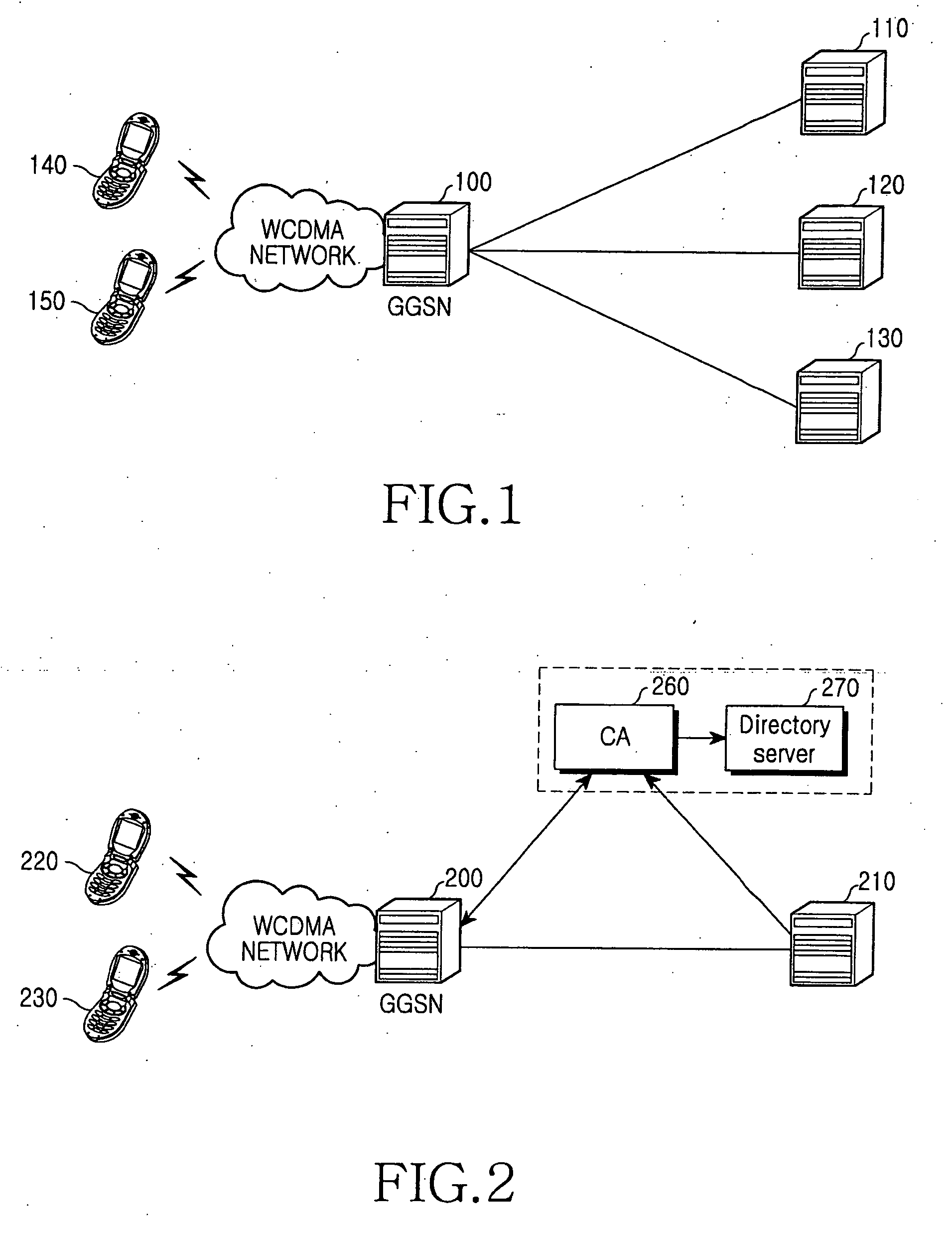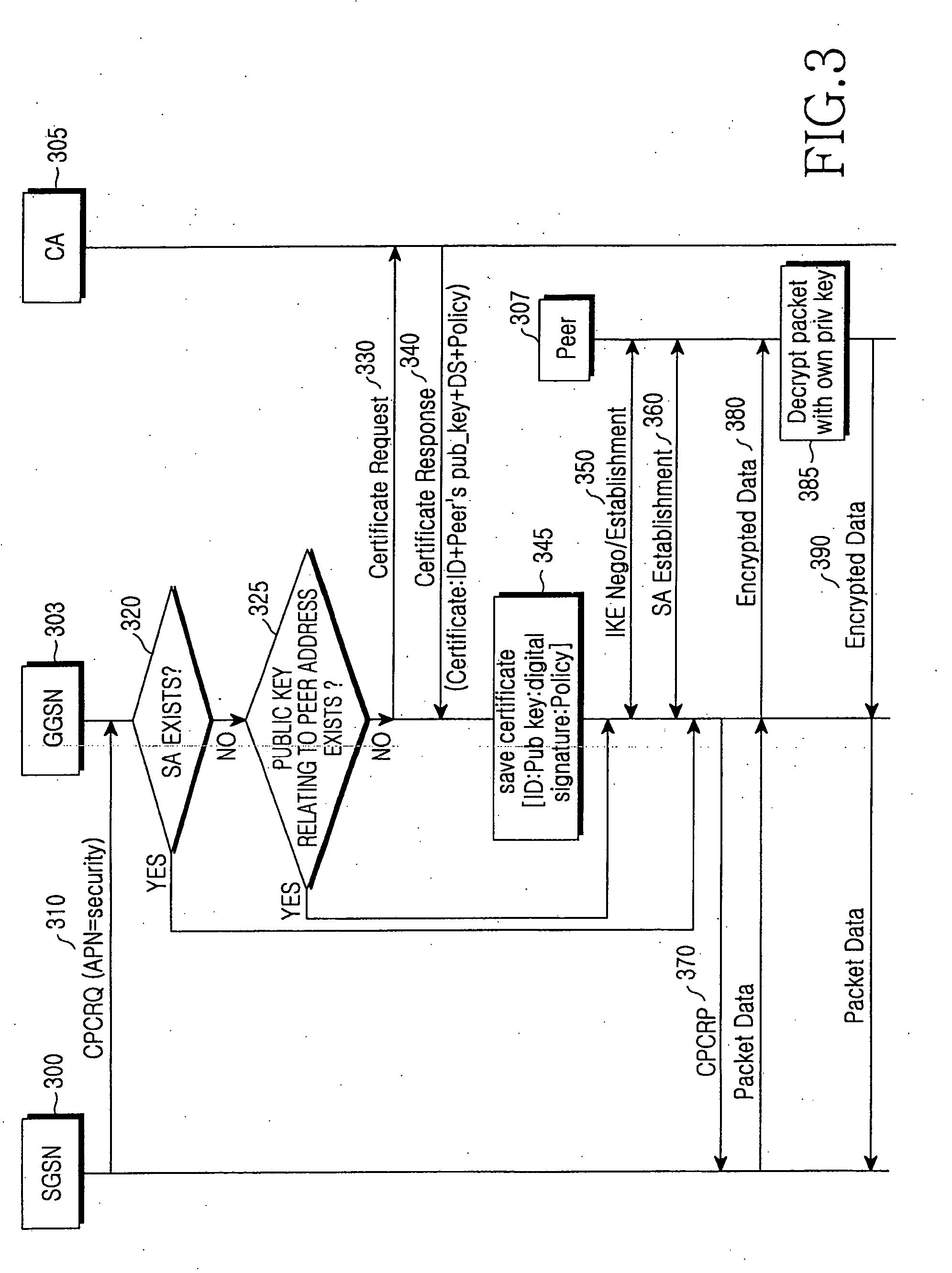Method and apparatus for security of IP security tunnel using public key infrastructure in mobile communication network
a public key infrastructure and tunnel technology, applied in the internet field, can solve the problems of degrading the security of keys, distributing psks, inconvenient ggsn keys according to sas, etc., and achieve the effect of reducing the load imposed
- Summary
- Abstract
- Description
- Claims
- Application Information
AI Technical Summary
Benefits of technology
Problems solved by technology
Method used
Image
Examples
first embodiment
[0060]FIG. 3 is a flowchart illustrating an operational procedure in a UMTS network according to the present invention. That is, FIG. 3 shows the case in which a GGSN requests a certificate without using a key update function when the GGSN receives a CPCRQ including a specific APN.
[0061] In the method illustrated in FIG. 3, a mobile node attempts a call to an APN (security) related to a specific security service through an SSGN in order to receive the specific security service. In step 310, the SGSN 300 sends a CPCRQ message including the APN (security) to a GGSN 303. In step 320, the GGSN 303 determines whether or not SA for the APN exists. If SA for the APN exists, the GGSN 303 proceeds to step 370.
[0062] In contrast, if SA for the APN does not exist, the GGSN 303 proceeds to step 325, in which the GGSN 303 determines whether or not a public key related to a peer address exists in a pre-stored security table. If a public key related to the peer address exists, step 350 is perform...
second embodiment
[0067]FIG. 4 is a flowchart illustrating an operational procedure in a UMTS network according to the present invention.
[0068] That is, FIG. 4 shows the case in which a GGSN requests a certificate without using a key update function when the GGSN receives a packet filtered based on an ACL.
[0069] In the second embodiment shown in FIG. 4, IKE establishment is initiated at the precise moment when packet data received from a mobile node matches the ACL after a GTP tunnel is created. The GGSN 403 determines whether or not SA for a peer exists, and sends a certificate request message if SA for the peer does not exist. A detailed procedure of these operations is as follows:
[0070] In the method illustrated in FIG. 4, in step 410, a mobile node initiates a call to create a GTP tunnel between an SGSN 401 and the GGSN 403. The mobile node transmits a packet, which is desired to be transmitted to a peer, to the GGSN 403 through the created tunnel. In step 420, the GGSN 403 determines whether o...
third embodiment
[0079]FIG. 5 is a flowchart illustrating an operational procedure in a CDMA network according to the present invention.
[0080] A detailed procedure for applying PKI will now be described. In the method illustrated in FIG. 5, in order for a mobile node 500 to be provided with a specific security service, a PCF 502 transmits a registration request message for session establishment to a PDSN 504 in step 510. Then, the PDSN 504 transmits a registration response message to the PCF 502 to establish a session in step 515.
[0081] In step 520, an LCP negotiation procedure is performed between the mobile node 500 and the PDSN 504, thereby establishing an authentication scheme. Herein, although authentication may be unnecessary, authentication essentially must be performed in order to use a security service. While performing an LCP negotiation procedure with the mobile node 500, the PDSN 504 receives “NAI (abc@security.com)” from the mobile node 500 by means of a predetermined scheme.
[0082] Af...
PUM
 Login to View More
Login to View More Abstract
Description
Claims
Application Information
 Login to View More
Login to View More - R&D
- Intellectual Property
- Life Sciences
- Materials
- Tech Scout
- Unparalleled Data Quality
- Higher Quality Content
- 60% Fewer Hallucinations
Browse by: Latest US Patents, China's latest patents, Technical Efficacy Thesaurus, Application Domain, Technology Topic, Popular Technical Reports.
© 2025 PatSnap. All rights reserved.Legal|Privacy policy|Modern Slavery Act Transparency Statement|Sitemap|About US| Contact US: help@patsnap.com



